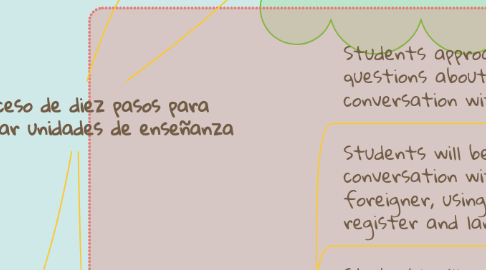
1. ELEMENTOS PRINCIPALES DEL PROCESO DE DIEZ PASOS PARA CREAR Y REVISAR MATERIALES GENERADOS POR MAESTROS
1.1. The ability of teachers to create their own materials
1.1.1. The application of a backward design model
1.2. The significance of reflection in teaching
2. TEN STEPS FOR DEVELOPING
2.1. Student needs
2.1.1. Goals and objectives
2.1.1.1. Test tasks
2.2. Language and skills
2.2.1. Sequence
2.2.1.1. Materials
2.2.1.1.1. Teaching
2.3. Reflection
2.3.1. Evaluation
2.3.1.1. Revisions
3. CONCLUSION
3.1. The specialist model produces a variety of curricular policies, materials, and products, mong which is the mass-market coursebook
3.2. After establishing who is qualified, the next natural question is how to do it
3.3. It has offered us a means to create teaching units over time and allowed
4. The teacher’s role is to implement the course and use materials received from the specialists
4.1. model of curriculum design is a misalignment
4.1.1. While coursebooks can fit this role adequately when
4.1.2. They are a suitable match for the context
4.1.3. El modelo de diseño curricular es una desalineación.
5. Otras sugerencias
5.1. Students approached teachers with questions about how to start a conversation with a foreigner
5.2. Students will be able to initiate a first-time conversation with a foreigner, using context-appropriate register and language
5.3. Students will conduct a role play with a classmate wherein a student
5.4. Se generaron dos frases de saludo en la práctica de Prueba de Prueba:
5.4.1. “Hey, how’s it going?” (lower register)
5.4.1.1. “Good morning/afternoon/evening.” (higher register)
5.5. Lesson 1 – Students will distinguish between and practice high- and low-register greetings and responses
5.5.1. Lección 2: los estudiantes comenzarán a aplicar el lenguaje aprendido a diferentes situaciones y contextos posibles fuera del aula de idiomas
5.5.1.1. Lesson 3 – Students will begin to shift among a wider variety of highand low-register contexts and integrate them into complete role plays
5.5.1.1.1. Handouts were created to provide language support
